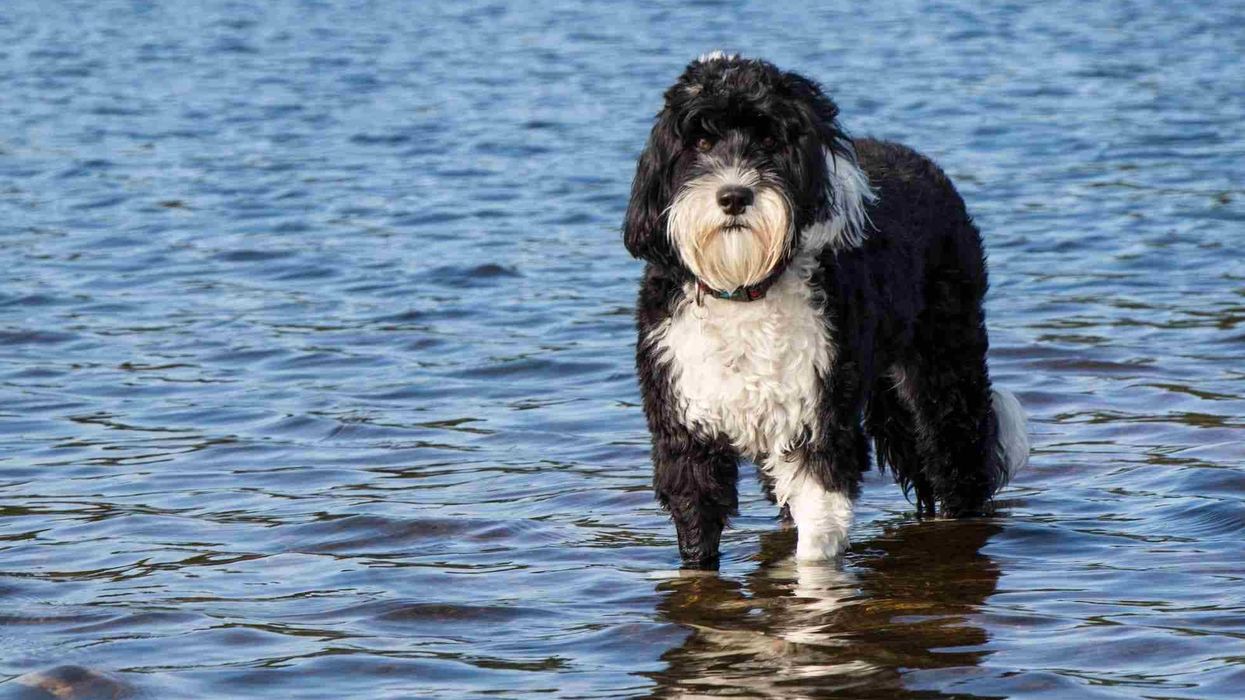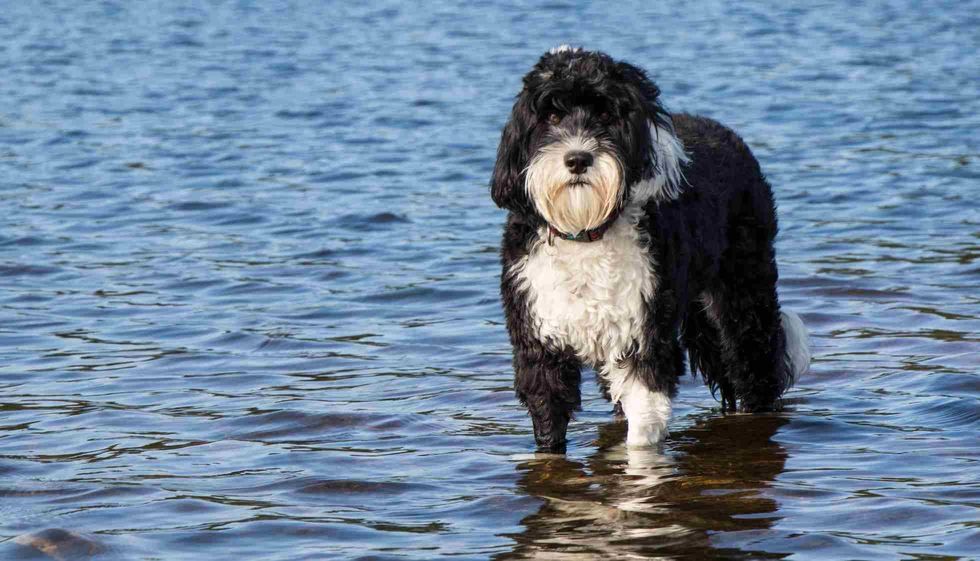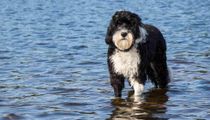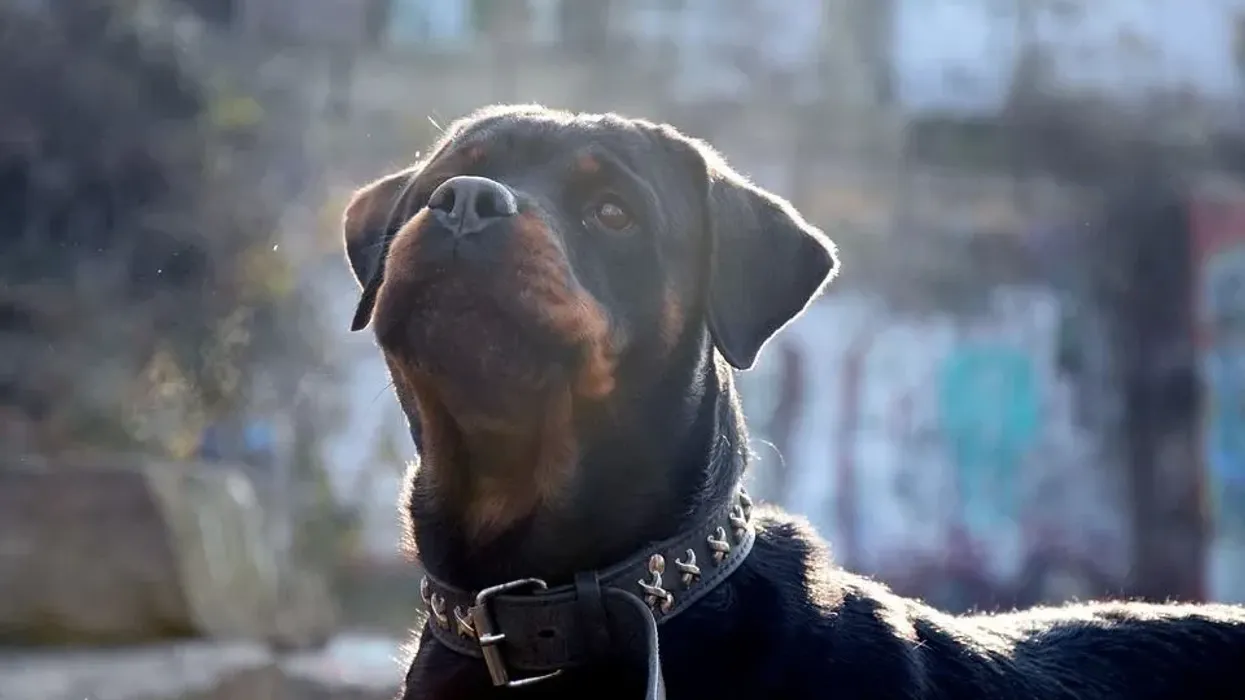Fun Portuguese Water Dog Facts For Kids

Content
- What type of animal is a Portuguese water dog?
- What class of animal does a Portuguese water dog belong to?
- How many Portuguese water dogs are there in the world?
- Where does a Portuguese water dog live?
- What is a Portuguese water dog's habitat?
- Who do Portuguese water dogs live with?
- How long does a Portuguese water dog live?
- How do they reproduce?
- What is their conservation status?
- What do Portuguese water dogs look like?
- How cute are they?
- How do they communicate?
- How big is a Portuguese water dog?
- How fast can a Portuguese water dog run?
- How much does a Portuguese water dog weigh?
- What are the male and female names of the species?
- What would you call a baby Portuguese water dog?
- What do they eat?
- Are they slobbery?
- Would they make a good pet?
- Did you know...
- History of the Portuguese water dog
- How do you groom a Portuguese water dog?
Are you searching for the perfect dog breed that will work out for your environment? If yes, then you are in the right place to learn about the Portuguese water dog.
This breed is also known as a Portie because of its Portuguese descent. Once used mainly as working dogs to catch fish, this breed is agile and highly intelligent.
The muscular body of this dog helps it keep up with its high energy. It is a great breed for those who are searching for a dog to adapt to apartment living.
The Portuguese water dog temperament is quite affectionate, and their medium-large height makes them a perfect pet for many. One of the most remarkably striking things about these dogs has to be their beautiful coat that comes in a wavy or curly pattern.
They have fairly good health, and with your love and affection, these dogs can have a long and healthy life.
Even Barack Obama has adopted two dogs of this same breed! Want to learn more Portuguese water dog facts?
Keep reading to find more interesting things about this dog breed. Also, check out our articles on the English cocker spaniel and Presa Canario to know more about different dog breeds.
Portuguese Water Dog Interesting Facts
What type of animal is a Portuguese water dog?
The Portuguese water dog is a type of dog breed. These dogs have been classified as working dogs by the American Kennel Club.
What class of animal does a Portuguese water dog belong to?
Like other dogs, the Portuguese water dog also belongs to the class Mammalia and the family Canidae.
How many Portuguese water dogs are there in the world?
It is not known how many of these dogs are there in the world. They are still fairly rare but their population is not considered to be under any threat.
Where does a Portuguese water dog live?
The Portuguese water dog lives in human households with their parents. They were one of the popular dog breeds that were used for hunting fishes, and they were quite good at it.
The Portuguese water dog is an ancient dog breed that is said to have originated in the central Asiatic steppes. However, they were more prolifically found on the Portuguese coasts, which also gives them their name.
What is a Portuguese water dog's habitat?
The Portuguese water dog prefers a comfortable home that is neither too hot nor too cold. They are known to adapt very well to apartment living, but you need to make sure that the dog gets enough space.
The Portuguese water dog is affectionate and behaves well both with humans and other pets. These dogs aren't fussy with strangers, but you should start training them from their puppyhood. These are playful dogs, so you should have enough toys to keep them engaged.
Who do Portuguese water dogs live with?
The Portuguese water dog breeds are great with humans, and they are affectionate towards their pet parents. The dogs will also love your children and cohabit with other pets that you might have.
They are calm in their approach. Strangers may get intimidated by them, and the Portuguese water dog may not like to be touched on their very first meeting with someone new.
You should also know that these dogs don't do well when left alone. If you leave a Portuguese water dog alone for too long, they can develop separation anxiety.
One of the Portuguese water dog's nicknames includes being one of the velcro dog breeds as they are quite clingy to their owners. Although we do appreciate it as a plus point as the dog breed is quite devoted to its pet parents.
How long does a Portuguese water dog live?
The average Portuguese water dog lifespan is around 10-14 years. The life span of any dog depends a lot on its health.
So, the pet parents should be careful about giving them the best life possible to let them have the maximum life span. It includes giving them the healthiest of food which includes the right amount of protein and healthy fats. Regular vet visits are important for maintaining the life span of the Portuguese water dog.
How do they reproduce?
The reproduction in dogs depends on the estrus (heat) cycles of the female. The males do not have a particular breeding season. Instead, they will wait for the females to go into heat, and mating during that time will end up in a pregnancy.
Dogs generally have two estrus cycles per year, so they can ideally have two sets of litters. The usual time period of sexuality is between 6-15 months from their birth.
Female dogs reach sexual maturity faster than male dogs. A female Portuguese water dog can have four to eight puppies in one litter. It can be less or more, depending on the size of the dog.
The Portuguese water dog puppies are born with closed eyes. In the first two weeks, the dogs are totally dependent on their mother.
In the phase lasting between two to four weeks, you can see the puppies interacting with their littermates. In the fourth week, the puppies also start to get weaned from their mothers, and you can see them nibble on the mother's food.
The Portuguese water dogs are purebred dogs, so you will need to find another similar dog to make similar puppies.
Also, it is really important to get your dogs from responsible breeders. If you choose to breed your dog, make sure to get them to have regular appointments with the vet.
What is their conservation status?
The Portuguese water dog is yet to be included in any conservation list. However, they are still considered to be a rare breed because these dogs are yet to become very popular. Barack Obama's dog, Bo Obama, has had an influence on people wanting to adopt this lovely dog breed.
Portuguese Water Dog Fun Facts
What do Portuguese water dogs look like?
The appearance of the Portuguese water dogs is enhanced by their curly coat. The dog breed can have two types of coat, wavy and curly.
They are found in a number of colors like black and white, solid black, shades of brown, brown and white, and others.
Breeding a Portuguese water dog with a particular coat color with another one of the same breeds with a different coat color can lead to more coat variations. However, if you want the dog to participate in sports events, you may need them to have a coat color that's recognized by the American Kennel Club.
The Portuguese water dogs with curly coats have tighter curls, and their coat may look less shiny. Grooming these dogs requires patience as improper brushing may lead to brushing.
The Portuguese water dogs with wavy coats have more lustrous fur coverings, and their hair does appear longer. They have a single coat without an undercoat which gives them an advantage of less shedding.
The Portuguese water dogs have an uneven coat as it is less bushy on its underside, and its tail tends to be quite fluffy.
The Portuguese water dog has a large head with medium size eyes that are either black or some shade of brown. The color of its eye rims depends on the color of its coat.
So, a Portuguese water dog with a solid black coat will have black eye rims. The dogs have droopy ears which are engulfed by their curly or wavy coat.
The Portuguese water dog also has a broad and deep chest. Its whole body is muscular, and its backs are quite strong. These dogs also have a thickly set tail that curves upwards, and it is helpful for them during swimming.
This dog breed was extensively used by fishermen to get fish into nets, so they adapted for getting into the water. These dogs have rounded, flat, and webbed feet. Their forefeet and hindfeet are quite similar in shape with muscular and strong built.
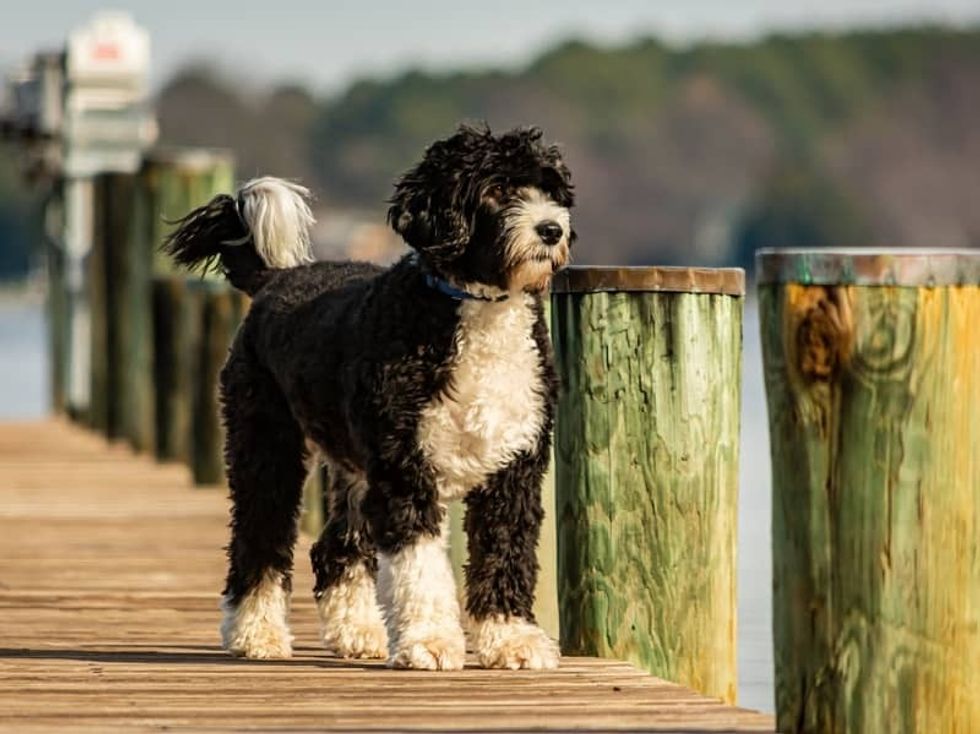
How cute are they?
Like any other canine, the Portuguese water dogs are cute, and they are great family pets. Its all-over coat cover makes the dog breed even more appealing. Some people also search for rarer coat colors to have a unique dog for themselves. The calm and affectionate Portuguese water dog breed temperament makes them cuter.
How do they communicate?
One of the things to remember about Portuguese water dogs is that they might have a tendency to bark. They do it out of affection, and they will often try to communicate with their humans with the help of barking.
They are eager to please dogs, so their affection might be too high at times. The best way to control their barking is to train them from an early age.
Proper training helps them to learn more intelligent cues other than taking the help of barking.
As an intelligent breed, the Portuguese water dog can surely learn a lot of things very easily. Another form of their communication is through the use of urine.
This is mostly used by the dogs to spread their scent over territory to demarcate it or to help a mate in locating them. You can neuter or spay a dog to limit its use of urine marking.
How big is a Portuguese water dog?
The average height of a Portuguese water dog is around 17-23 in (43-57 cm). It makes them a medium-large-sized dog. The females are slightly smaller compared to the males. They are similar in size or slightly smaller than the standard Poodle that gets to an average height of 17-23 in (45-60 cm).
How fast can a Portuguese water dog run?
The exact speed of the Portuguese water dogs is yet to be studied. However, they will surely have an average speed of 15-20 mph (24.1-32.2 kph), which is the usual speed of a dog.
In cases of emergency, most dogs can also manage to run faster. One of the unique capabilities of the Portuguese water dog is its ability to swim and dive. They have been extensively used to herd fish because of this quality.
How much does a Portuguese water dog weigh?
The average weight of a Portuguese water dog is around 35-60 lb (16-27 kg). The weight of a dog depends on different factors.
One of them being their height, and the other being their diet. This is also the reason why the female dogs of the breed tend to be smaller than the male dogs.
A Portuguese water dog needs to have a proper diet to thrive in health as well as in weight.
Like many other dogs, this breed also has the problem of gaining extra weight. Pet parents may often look at their puppy eyes and give them extra food, but it can be detrimental to their health.
One of the things that pet parents should do is to visit a vet to chalk out a weight management plan for the dog, which will definitely include a health-enhancing diet. Too much weight can lead to health problems like cardiovascular issues, diabetes, thyroid anomaly, and hip dysplasia.
What are the male and female names of the species?
The male of the Portuguese water dog breed is known as a dog, and the female dog is known as a bitch.
What would you call a baby Portuguese water dog?
A baby Portuguese water dog is called a puppy. It takes 12-15 months for a Portie to grow from a puppy to be an adult.
What do they eat?
One of the most important parts of keeping a dog is to maintain a proper diet. The food for dogs needs to be appropriate for them, and it should be devoid of any human food that can affect their health.
An adult Portuguese water dog will have 2.5-3.5 cups daily on average. The quantity of food will depend on the weight and height of the dog, along with its energy level.
The dog food that you choose should be meant for similar dogs as the Portuguese water dog that has high working energy.
Hence, the food should be rich in protein and good fat that will help to replenish their high energy storage. As a pet parent, the first thing to do is to visit a vet to chalk out a meal plan for your dog.
The dietary need of a dog will also change with its age and its state of health. A dog that is suffering from a health issue may require a specialized mix of food.
Similarly, the puppies often need different food compared to that of the adults. As a water-loving dog breed, the Portuguese water dogs should have unlimited access to clean and filtered water. Another breed that loves water is the Newfoundland.
Are they slobbery?
Not a lot, but still, these breeds of dogs can be a little slobbery at times, so you need to quickly clean their mouths during such situations to avoid the matting of their coats. During summers, let the dog have fun in the water as they love to swim.
Would they make a good pet?
Have you been thinking of getting a Portuguese water dog as your pet? If yes, then here are some of the things that you should know.
They do make great family pets because of their affectionate nature. These dogs would love to please their humans, and they are quite devoted to their owners.
You can get a Portuguese water dog from a responsible owner, and it will cost you around $1500-$2500. You may need to pay a little bit more for ones with rare colored coats. These dogs adapt well to apartment living, but they will indeed appreciate it if there is enough space for them to use their energy.
However, if you are a first-time dog parent, then you may avoid getting a Portie. These dogs work well with other pets as well as children.
They don't fare well when left alone, so you should not leave them alone for more than a few hours. These dogs seldom get aggressive, and a little pat on their head and lots of affection can easily calm them down.
Training a Portuguese water dog is fairly easy, and you should start it from their puppy stage. As highly intelligent dogs, they can be trained easily with the help of treats.
If you are unsure about training them, get a pet trainer to make the job a tad easier. As the Portuguese water dog has long been used as a working dog, they are highly energetic.
Every day you will need to spend 45 minutes to an hour on their exercise. As they are smart, these dogs can easily learn tricks, and they can communicate with their owners in various ways.
These dogs even use expressive panting as a way to communicate with their master. Help the puppies to socialize with other people and animals so that they can be trained to be around them.
It is a common belief that the Portuguese water dog is hypoallergenic. However, science is yet to prove that any dog can be completely free from triggering allergies.
Nevertheless, these are low shedding dogs, so you wouldn't need to worry about having their fur all over the place. Yes, they do shed, but a bi-weekly brushing would save you from having a mess around your apartment.
Consult a health physician before getting any dog to make sure that they wouldn't trigger your allergy. Also, it is a common belief that the Portie is a smelly breed, but that isn't correct. With proper grooming and regular brushing, the smell can easily be avoided.
If you happen to notice that your dog has an off-putting smell, consult a vet to get to its root. Always consult a vet to know more about properly raising a Portuguese water dog.
Another facet that is often overlooked while adopting a puppy is their health. It is important to get a puppy from a good breeder to avoid unforeseen health conditions.
Other than that, these are some of the health problems seen in Porties: hip dysplasia, obesity, juvenile dilated cardiomyopathy, storage disease (GM1), and progressive retinal atrophy (PRA). Hence, you should get the puppy checked as soon as possible to give them the best health.
Did you know...
The Portuguese water dog is called 'cau de agua' in the Portuguese language which stands for the dog of water. Other names include the Algarvian water dog and the Portuguese fishing dog.
History of the Portuguese water dog
Dogs have been tied with human beings for ages. The Portuguese water dog history is quite unique, and a probable pet parent should know about these high-energy dogs before bringing them home.
If we start from the very beginning, it is said that the Portuguese water dogs and the Poodles share a similar gene pool. These dogs might have had a longer coat in the past, which has now evolved to become a much smaller coat.
They have descended from other water dogs, which were used by fishermen to put fish into nets when they are in the waters.
These dogs were extensively used as working dogs on the coast of Portugal, and they would also be taken on trips in the sea, sometimes as far as the freezing waters of Iceland. Even though they aren't currently used as fishing dogs, they are still a popular breed to be trained for rescue missions.
Humans do owe a lot to these highly intelligent dogs. These dogs traveled to the Atlantic waters with humans, especially to catch cod.
However, as fishing technology started to improve, these dogs became rarer to spot in the 1930s. A Portuguese breeder, Vasco Bensaude, became an important part of restoring the breed, and he set up a kennel called Algarbiorum.
Another important person who made an immense contribution to this breed was Dr. António Cabral. He set up the Avalade kennels.
He worked with people like Carla Molinari, Deyanne Miller, and Sonja Santos to establish the Portie in the USA. Cabral even bred his dogs to have a special mark called the Mark of Cabral, a triangular-shaped mark found two to three inches from the base of the dog's tail.
If we carefully look at the modern history of the Portie in America, then most of the credit should go to Deyanne Miller. The Portuguese Water Dog Club of America, Inc. (PWDCA) was set up in 1972.
She has worked with dogs from both Cintron and Cabral lineages to create a more diverse gene pool. Miller was also the founder of the Farmion kennels.
Raymond Burr was another key North American breeder of the Portuguese water dogs. Currently, these dogs are quite renowned around the world, and a chunk of them is found in the USA.
Former president of the United States of America, Barack Obama, has two Porties who are called Bo and Sunny. The American Kennel Club recognized them in 1983 as their 128th dog breed.
How do you groom a Portuguese water dog?
One of the most elaborate things about a Portuguese water dog is its need for grooming. Even though these dogs do not shed a lot, you need to brush their coat twice or thrice a week to keep it healthy and knot-free.
When it comes to getting your dog a haircut, it is mainly available in two styles, the lion cut, and the retriever cut.
In the lion cut, the dog's body hair is left intact while its tail is trimmed to its one-third proportion, along with its hindquarters and muzzle.
This form of grooming was mainly used to help the dogs stay comfortable in cold waters as they were used as a working breed. As the hindquarters are shaved, it allows the working breed to navigate the water far more easily.
The more common cut that is done today is the retriever cut as the Portuguese water dog has transformed to become a great pet instead of just being a working dog. In this cut, the coat is trimmed to 1 in (2.5 cm), and it's even all over the body.
Some pet parents may still like to shave the tail down to one-third for the look of the lion cut. This cut is mostly for aesthetic purposes, and many owners prefer having dogs with evenly clipped coats.
The frequency of clipping the coat will depend on the dog's hair growth rate.
However, it is usual for parents of the Portuguese water dog breed to give them a monthly clipping or once every two months. During the usual shedding season, make sure to give them daily brushing sessions to maintain the health of their coat.
The regular grooming needs of a dog also include cleaning its ears and teeth. It is best if you can do it along with their bi-weekly brushing.
The breed also needs occasional bathing, which can be done once a month. Make sure to use dog-safe products while bathing any dog breed. It is important to start the grooming sessions early on in their life so that they can get used to it.
Here at Kidadl, we have carefully created lots of interesting family-friendly animal facts for everyone to discover! Learn more about some other dogs from our Keeshond facts and Swedish Vallhund facts pages.
You can even occupy yourself at home by coloring in one of our free printable Portuguese water dog coloring pages.
We Want Your Photos!
More for You
See All
Bachelor of Arts specializing in Journalism and Mass Communication, Postgraduate Diploma in Sports Management

Moumita DuttaBachelor of Arts specializing in Journalism and Mass Communication, Postgraduate Diploma in Sports Management
A content writer and editor with a passion for sports, Moumita has honed her skills in producing compelling match reports and stories about sporting heroes. She holds a degree in Journalism and Mass Communication from the Indian Institute of Social Welfare and Business Management, Calcutta University, alongside a postgraduate diploma in Sports Management.
Bachelor of Arts specializing in Economics

Gowri RaoBachelor of Arts specializing in Economics
With a bachelor's degree in Economics from Krea University, Gowri is a highly skilled data analyst and an expert in regression and causation modeling. Her interests in economic trends, finance, and investment research complement her professional expertise. In addition to her professional pursuits, Gowri enjoys swimming, running, and playing the drums, and she is also a talented tutor.
Disclaimer
1) Kidadl is independent and to make our service free to you the reader we are supported by advertising. We hope you love our recommendations for products and services! What we suggest is selected independently by the Kidadl team. If you purchase using the Buy Now button we may earn a small commission. This does not influence our choices. Prices are correct and items are available at the time the article was published but we cannot guarantee that on the time of reading. Please note that Kidadl is a participant in the Amazon Services LLC Associates Program, an affiliate advertising program designed to provide a means for sites to earn advertising fees by advertising and linking to Amazon. We also link to other websites, but are not responsible for their content.
2) At Kidadl, we strive to recommend the very best activities and events. We will always aim to give you accurate information at the date of publication - however, information does change, so it’s important you do your own research, double-check and make the decision that is right for your family. We recognise that not all activities and ideas are appropriate for all children and families or in all circumstances. Our recommended activities are based on age but these are a guide. We recommend that these ideas are used as inspiration, that ideas are undertaken with appropriate adult supervision, and that each adult uses their own discretion and knowledge of their children to consider the safety and suitability. Kidadl cannot accept liability for the execution of these ideas, and parental supervision is advised at all times, as safety is paramount. Anyone using the information provided by Kidadl does so at their own risk and we can not accept liability if things go wrong.
3) Because we are an educational resource, we have quotes and facts about a range of historical and modern figures. We do not endorse the actions of or rhetoric of all the people included in these collections, but we think they are important for growing minds to learn about under the guidance of parents or guardians.
